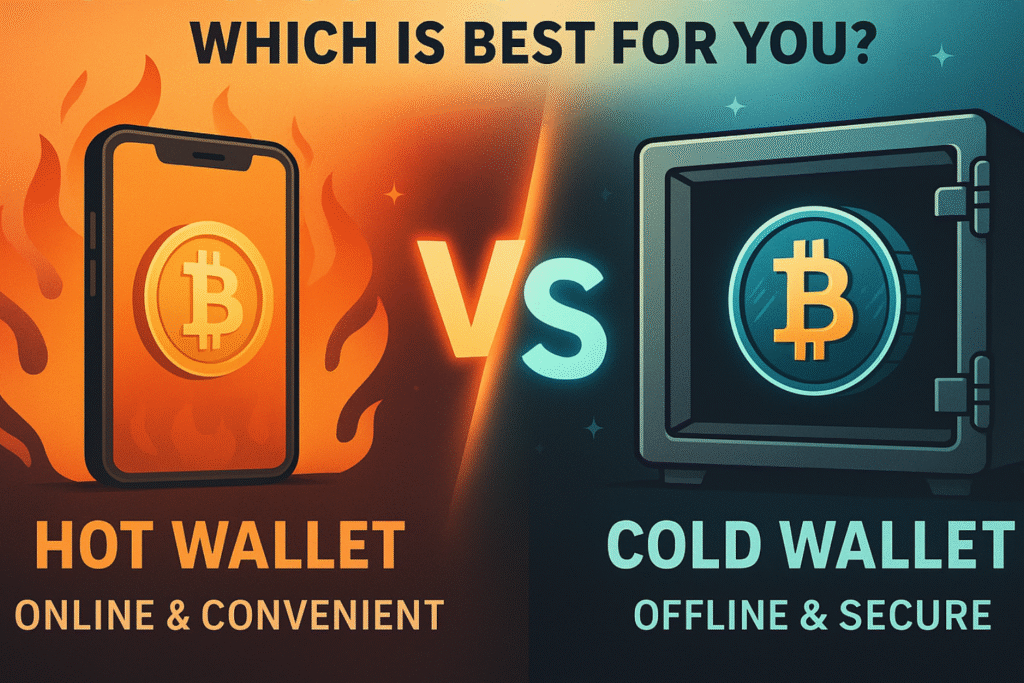⚠︎ Disclaimer: Cryptocurrency is a high-risk asset class. This content is for informational purposes only and does not constitute financial or investment advice. You may lose all of your capital. KoinGuide may earn a commission if you visit or sign up with a recommended provider via our affiliate links—at no additional cost to you. All recommendations are based on our independent reviews and evaluation process.
Hot vs. Cold Crypto Wallets: Which Is Best for You?

Crypto wallets hold your digital money, but they come in two main types: hot wallets and cold wallets. Hot wallets are online and handy for quick use, while cold wallets are offline and super secure for long-term storage. Choosing the right one depends on how you use your crypto—whether you’re trading daily or just holding for the future. This guide breaks it down simply so you can pick what fits your needs.
What Are Hot and Cold Wallets?
Hot Wallets: These are connected to the internet, like apps or websites (e.g., Coinbase, Binance, or MetaMask). They’re convenient but more exposed to hacks.
Cold Wallets: These are offline, like hardware devices (e.g., Ledger, Trezor) or paper with your seed phrase. They’re safer but less convenient for frequent trades.
Hot Wallets: The Quick Option
Hot wallets are great if you’re active in crypto. Here’s the scoop:
How They Work: You access them through a phone app, browser extension, or exchange account. Your private keys (the codes to your crypto) are stored online.
Pros:
-
- Easy to use and set up—perfect for beginners.
- Fast for trading or spending crypto.
- Often free with exchanges or apps.
Cons:
-
- Riskier—hackers can target them since they’re online.
- Exchanges can freeze your funds if they face issues.
- Not ideal for storing large amounts long-term.
Best For: Daily traders, small balances, or people just starting out.
Cold Wallets: The Safe Haven
Cold wallets are your go-to for keeping crypto secure. Here’s what to know:
How They Work: Hardware wallets are USB-like devices that store your private keys offline. Paper wallets are printed seed phrases or keys you keep safe. No internet connection means no hack risk.
Pros:
-
- Super secure—hackers can’t touch them online.
- Great for holding big investments or HODLing (holding long-term).
- You control your keys, not a company.
Cons:
-
- Takes more effort to set up and use.
- Can cost money (e.g., $50-$150 for a hardware wallet).
- Slow for trading since you need to connect or transfer funds.
Best For: Long-term investors, large crypto holdings, or anyone prioritizing security.
Key Differences to Consider
- Security: Cold wallets win—offline means no remote attacks. Hot wallets are vulnerable but fine for small, active use.
- Convenience: Hot wallets are quick for trades or payments. Cold wallets need manual steps, like plugging in a device.
- Cost: Hot wallets are usually free; cold wallets have an upfront price but save you from potential losses.
- Access: Hot wallets work anywhere with internet. Cold wallets need physical access, which can be a hassle or a safety perk.
How to Choose the Right One
Pick based on your crypto habits and comfort level:
- If You Trade Often: Go with a hot wallet. Use a trusted app like MetaMask or an exchange wallet. Keep only what you need for a short time—move the rest to a cold wallet.
- If You’re Holding Long-Term: Choose a cold wallet. Get a hardware device like a Ledger or Trezor, or make a paper wallet if you’re on a budget. Store your seed phrase safely (see the last guide!).
- Mix and Match: Many people use both. Keep a hot wallet for daily use (e.g., $100-$500) and a cold wallet for the bulk of your crypto (e.g., thousands).
- Start Small: If you’re new, try a hot wallet to learn, then add a cold wallet as your stash grows.
Tips to Use Them Safely
- Hot Wallet Safety: Enable two-factor authentication (2FA) with an app (not SMS), use strong passwords, and never share your seed phrase. Move big funds to cold storage regularly.
- Cold Wallet Safety: Buy from official sources to avoid fakes, store your seed phrase offline (metal or paper in a safe), and test your setup with a small amount first.
- Backup Everything: Always have a secure backup of your seed phrase for either type. Lose it, and your crypto’s gone.
- Stay Updated: Check for software updates on hot wallets and firmware updates on cold devices to patch security holes.
Key Takeaways
- Hot Wallets: Best for convenience and small, active use. Use them smartly to limit risk.
- Cold Wallets: Best for security and long-term storage. Worth the effort for big investments.
- Your Call: Match the wallet to your goals—trade with hot, save with cold, or use both for balance.


